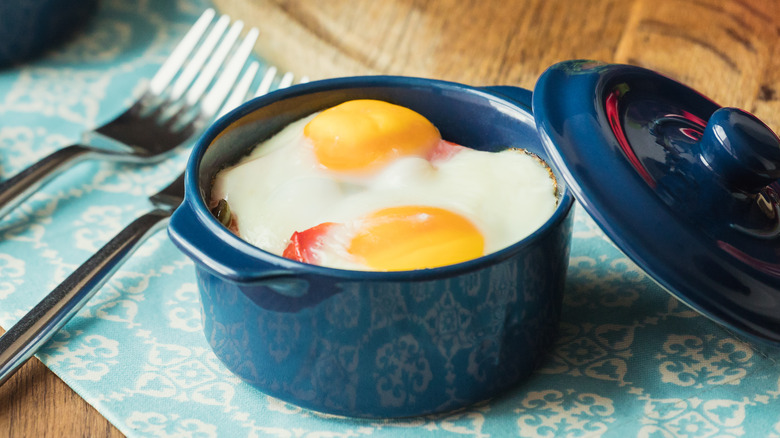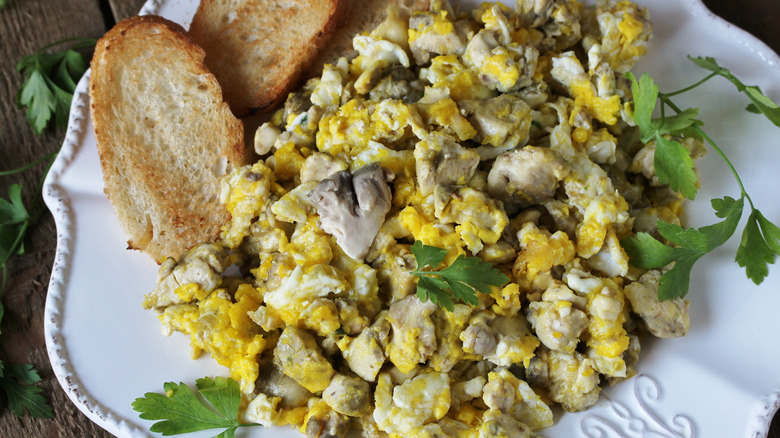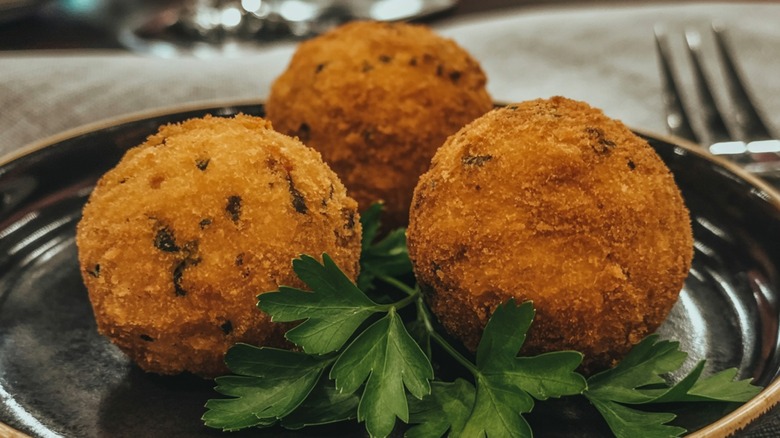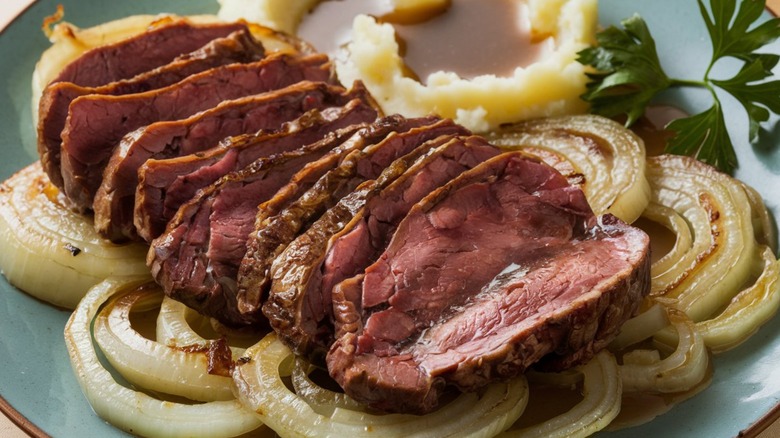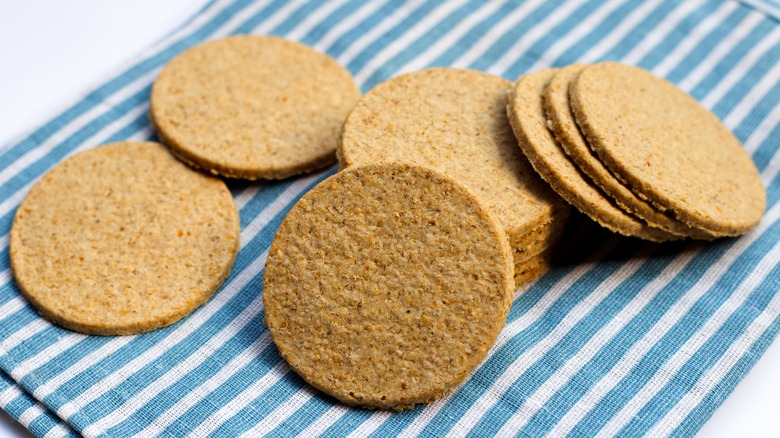10 Old-School Breakfast Dishes You Rarely See Today
We may receive a commission on purchases made from links.
For many people, the morning to-do list is taken up with getting the kids to school and ourselves to work on time. Older folks, with fewer demands first thing, can cook up something delicious to kick-start their day. For some, that means serving up eggs and bacon, for others, granola with yogurt and fresh fruit is the way to go.
If workday breakfasts are all about speed and efficiency, then weekends are a chance to indulge. Across the United States, household kitchens are filled with enticing aromas as dishes like grits, breakfast sausage, and biscuits are turned out. Many people also eat out for breakfast on a Saturday or Sunday, happily wolfing down the fruits of someone else's labors without worrying about the dishes. Interestingly, what Americans eat for breakfast has changed a lot over the years.
There was once a time when meatloaf was regarded as a breakfast staple but few would serve up that protein powerhouse today. It's not the only food that used to be on the menu first thing in the morning. Pancakes are still popular, but honestly, who eats Johnnycakes or hoecakes? Would you really reach for a slice of quiche with your morning joe? With all that in mind, we took a look at other old-school breakfast dishes you rarely see today.
Shirred eggs
In the 1950s and 1960s people across the United Kingdom were urged to "go to work on an egg," so they had a healthy, nutritious start to their day. Across the Pond, Americans needed no such prodding. Most of the eggs consumed in the United States are eaten at breakfast, because they can be cooked in many different ways — all of them delicious. But one method has fallen out of fashion in American kitchens, though we think it deserves to make a comeback.
Shirred eggs have been around since at least the 19th century and are simpler to make than they appear. Although they sound like they're named after a cooking method, shirred eggs are so called because of the dish used to make them — a flat-bottomed pot similar to a ramekin. Cooks would crack an egg into the shirrer, add a dash of heavy cream and bake them in an oven until the whites were just done, leaving the yolks runny and delicious.
Baked or shirred eggs were a popular food for decades — even appearing on the Titanic's menu for first class passengers — but were often victims of changing tastes and times. They last made a comeback in the 1960s in the United States, while the growing appetite for shakshuka has helped put baked eggs for breakfast back on the map. If you want to give them a whirl but don't have ramekins, they're a great alternative use for your muffin tin.
Beer soup
Even for the most ardent foodies, sometimes the past isn't so much another country as an alien planet. The things people were prepared to eat and drink way back when would horrify most of us today, and beer soup has to rank in the top 10. We know that people drank beer centuries ago and richer folks sipped wine, but what's less well-known is both drinks were on the breakfast menu.
Dipping bread into wine, beer and even spirits like brandy, was a perfectly acceptable way to start the day. However, in Germany, folks took it to another level. They kicked off their days with a concoction known as beer soup: a blend of dark beer, cream, flour, and egg yolk or fat. Some variations added spices and cheese, while Henriette Davidis' recipe from her 1876 "German national cookery for American kitchens" combined boiling beer, sugar, and salt to a paste made from flour and an egg yolk, which was then cooked over a fire.
Although it might sound gross, beer soup was enjoyed for hundreds of years, especially in Germany, with lots of different styles evolving across the country's regions. Immigrants to the United States brought lager with them, and while that took off in a big way, the same can't be said of beer soup. It's still a huge part of German culture, but the chances of it becoming a staple breakfast in the U.S. are slim.
Stewed prunes
Summer is plum season in the United States, and while foodies love this juicy, sweet stone fruit, the same can't be said for its cousin, the humble prune. Brought to the U.S. in the 19th century by European immigrants, plums and prunes became big business in California, until they were buffeted by trade policies and changing tastes. After the 1940s, appetite for prunes declined as a new generation of consumers wrinkled their noses at what they saw as a food for old people. Stewed prunes — once a widely eaten and delicious dessert, according to plant-based chef Char Nolan, who admits she is a big fan — belonged to our grandparents.
They were often eaten at breakfast to kick-start people's digestive systems, and it's arguably the main reason for their tarnished image. While dietitians and health experts talk up the benefits of eating prunes, stewed or otherwise, from boosting our bone, brain, and heart health to slowing the aging process, for years people couldn't move past the fact they're great for making us "go."
In the 21st century, stewed prunes are a long way from making a regular appearance at the nation's breakfast tables, but there are ways to rehabilitate this fiber-laden fruit. You can add them to a box brownie mix for a tasty brunch snack, or pop a handful of organic pitted prunes into a smoothie to get all the benefits. Your tummy and tastebuds will both thank you.
Scrambled brains and eggs
Millions of people start their day with a hot plate of scrambled eggs. Maybe they gussy it up with some bacon or ham to give it a savory boost. Some might toss in a little smoked salmon or mackerel to give their breakfast a kedgeree vibe. But there's one added extra that is rarely seen today: brains. Yup. You read that right. Pork brains, to be precise, were a much-loved addition to a plate of breakfast scrambled eggs, especially in the South.
A generation or so ago, farming families in the region needed a hearty breakfast before going to work, and they also understood the necessity of using every part of the animals they raised and slaughtered. That included the offal, and while traditionally the lungs (also known as "lights") were eaten for lunch, the brains were as much of a breakfast staple as sausage or bacon. Brains are also eaten first thing in Asia and some parts of Europe, though it's not as common as it once was.
If the thought of adding pork brains to your morning eggs doesn't leave you green around the gills, you can buy a can of them (in milk gravy, no less) online and start your day with a protein boost, just like your great-grandparents and grandparents. Just watch out for the cholesterol levels, though. A single 5-ounce can contains 3,190 milligrams.
Hominy grits
Although it has its origins in the South, grits is a delicious breakfast for millions of people up and down the United States, and has been for years. Erin Byers Murrary explores the food's story in her 2018 book "Grits: A Cultural and Culinary Journey Through the South," and right from the start, asserted that not all grits are "created equal." That includes hominy grits which, even though they have similar corn-based origins, should not be confused with traditional grits or their European cousin polenta (don't forget this tip when cooking it).
Hominy grits are the only ones made from nixtamalized corn: Grains that have been soaked in an alkaline solution (usually calcium hydroxide) for up to 12 hours to change their Ph. The nixtamalization process also allows the release of carotenoids and niacin in the corn, boosting its nutritional value, and ensuring it will stick together when turned into a dough. Hominy grits were widely eaten by Native Americans and still features in Latin American and Southeastern American cuisine, where it is sometimes added to pozole.
More rarely are hominy grits eaten as a breakfast food in the U.S., which is a shame because there's a lot to enjoy from a plateful. Hominy porridge is popular in the Caribbean, where home cooks add a dash of warm spice and sweeten it with condensed milk for a satisfying start to the day.
Dutch baby pancakes
Thanks to Hollywood, much of the world believes the average American breakfast includes a large stack of golden, fluffy pancakes. While many households do chow down on these delicious discs first thing, there's one particular form that has fallen out of favor in recent years. No, it's not this online crime against breakfast; it's the Dutch baby pancake.
This hot combination of crispy and soggy carbohydrate has its roots in German cuisine, but was created in the United States. The story goes that a Seattle eatery popped their pancakes in the oven to cook them, most likely to save time, while the name was an Americanization of the word "deutsch." Like pancakes, Dutch babies are made from a rich batter of eggs, flour, and milk. They can be filled with pretty much anything, from fresh or cooked fruit to meats and cheeses, but what really makes them stand out is the size.
These things will easily fill a skillet, and look more like a Yorkshire pudding (which is neither a dessert nor a pudding) than a dainty, traditional pancake. Not everyone can spare the up to eight eggs needed to make them from scratch, and unless you're feeding the multitudes, it's a lot of food to gobble down before the morning commute. No wonder people prefer smaller pancakes to Dutch babies.
Rice pudding
Everyone has their go-to comfort foods, whether it's a plate of silky, creamy mac and cheese or Judy Garland's signature dish. School lunch staple rice pudding probably features on many people's lists as a warming dessert or perhaps a naughty, late-night treat, but for breakfast? Chances are it doesn't even make the top 20, unless maybe you're a regular at New York's Rice to Riches, or a traditional diner, where rice pudding has been a breakfast menu item for around 100 years.
It may have lost its audience in the United States, but over in the Philippines, tourists are blown away by the local breakfast of champorado, a rich, chocolatey rice pudding that's about as everyday as boxed mac and cheese is in the U.S. The combination of rice cooked in milk or cream has been around since the 12th-century days of the Forme of Cury, while the sweet version adored by foodies came along in the 1400s.
Every now and again, rice pudding as a breakfast food makes a comeback among American households, giving boxed cereal or oatmeal a run for their money. It's a great way to use up leftover rice, which will stay nice and moist if you use this nifty hack. Add it to coconut milk if you're vegan, or cow's milk with a splash of cream for a richer mouthfeel, and sweetened with honey or sugar for a delicious, carb-tastic start to the day.
Codfish cakes
Away from the United States' coastal regions and outside Asian communities, fish is not an everyday breakfast choice for many American households. Go back in time a few hundred years and it's a very different story. Former president John Adams loved a codfish cake or two, cooked by his wife Abigail, for the first meal of the day, and he wasn't alone. Salted cod was a staple food in the U.S., and for Bermudians, their breakfast favorite has become a national dish.
Codfish cakes were a handy way to use up leftovers at a time when "waste not, want not," was a way of life, rather than a guideline. Today, everyone from home cooks to top chefs mix cold fish with mashed potato and herbs, before sautéing them to create crispy, golden rounds of savory goodness. However, fish cakes — whether they're made with flakes of white fish or a humble can of sardines — are more often a dinnertime recipe in the U.S., rather than a breakfast dish.
Health experts would be among the first to argue for codfish cakes to push back against the "convenience" foods that replaced them. Fish is a lighter form of protein than meat, and a great source of vitamin D and omega-3 fatty acids. Cod and other flaky white fish pairs amazingly with scrambled eggs (think a milder type of kedgeree) and if you don't have time to make fish cakes first thing in the morning, prep them the night before.
Liver and onions
It may have fed hungry Americans eating at local diners but across the Atlantic, liver and onions revolted millions of British schoolchildren (this writer included) whenever it appeared on the lunch menu. As for having it for breakfast? Plenty of people would happily side step it — but not so fast. Liver is full of iron, and combining it with fried onions boosts our vitamin A and B intake with every forkful. So, why does it have such a bad reputation as a breakfast food?
Aside from the weird texture, the flavor is the main culprit. All that iron gives liver its strong taste, while the thought of eating offal (as with brains, scrambled or not), isn't for everyone, especially when you've just gotten out of bed. But that's not to say it can't be rehabilitated. People in the Midwest, whose ancestors came from Germany and loved liver and onions, have a trick to help tamp down that robust flavor: Soak the meat in milk for around a half hour before cooking it.
Unlike some breakfast meats, liver takes just a few moments to cook, once it's been pre-soaked. Whether you opt for calves or pig's liver, season it before tossing it in flour for a fine coating, then pop it into a medium-hot pan. If the heat is too high, the flour coating will burn. Cook the liver until each is golden colored but the inside remains pink, and serve with caramelized onions.
Oatmeal with lard
Not to be confused with porridge, oatmeal is one of the most popular breakfasts in many countries, and the United States is quickly catching up. Although not all oats are created equal — some people prefer steel cut to rolled, for example — eating a bowl a day comes with plenty of health benefits, including soluble fiber and cutting cholesterol levels.
Many people add fresh fruit to their breakfast oatmeal, or a spoonful of honey for extra sweetness, but savory options are much less common. After all, when was the last time you plumped for oatmeal with lard? Dietitians and other experts whose job is watching our waistlines always have something to say about how much sugar we all consume, including with our morning oatmeal.
Switching to a savory version could be the solution. Lard, specifically pork fat, is like grass-fed butter or ghee, an unprocessed saturated fat that is packed with vitamin D. If you can find it from pasture-raised pigs, it could have up to 12 times the vitamins of caged animals. For centuries, lard added richness to a bowl of breakfast oatmeal, but you can also make what's known as "skirlie" to Scottish people. Blend chopped onion with the lard and oatmeal, cook it all in a skillet for around 10 minutes, and you have a delicious side to a plate of bacon and eggs. Alternatively, you can mix the oats and lard with a little salt and make breakfast oatcakes.

